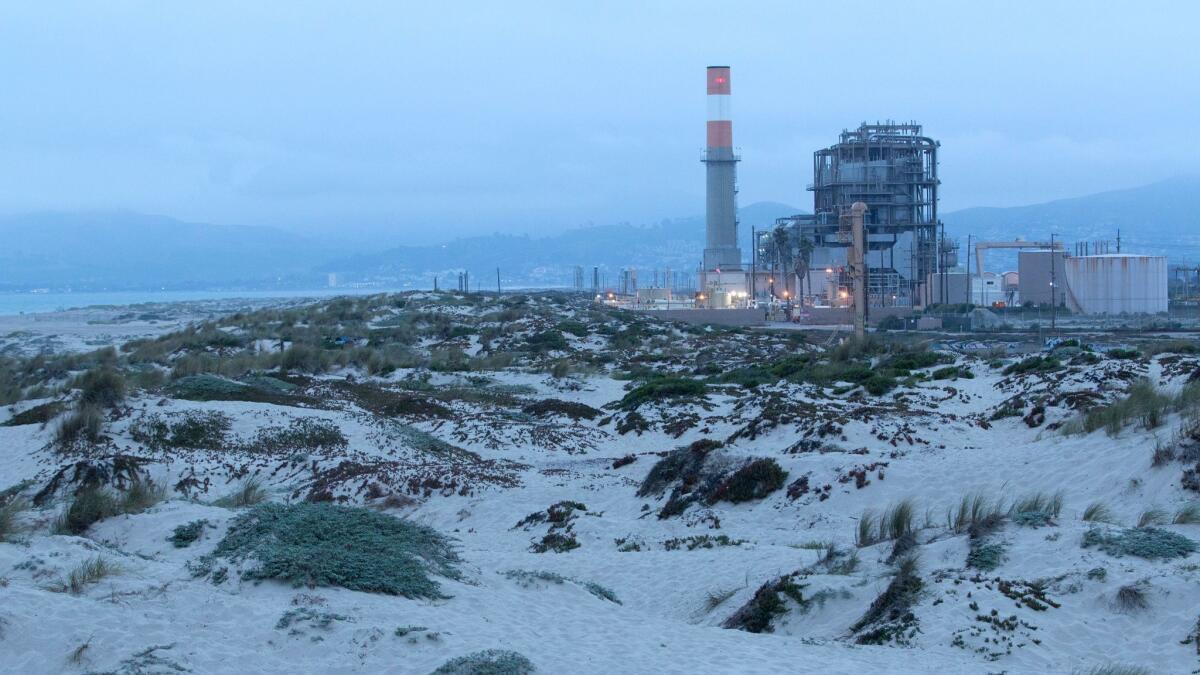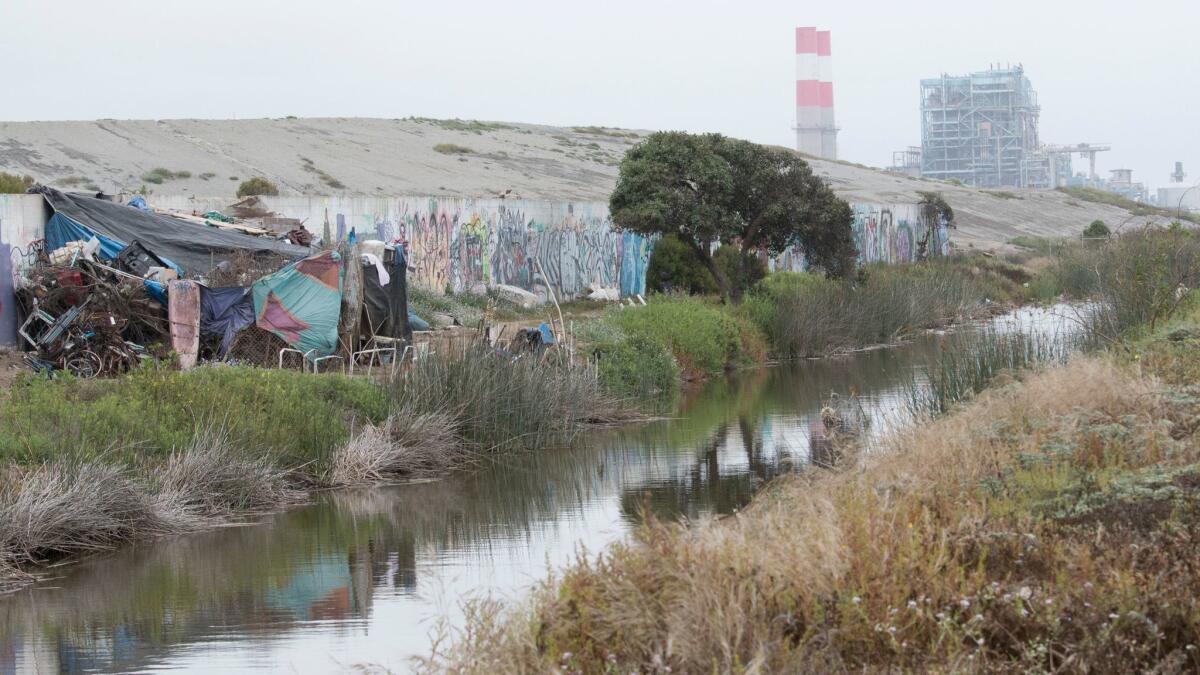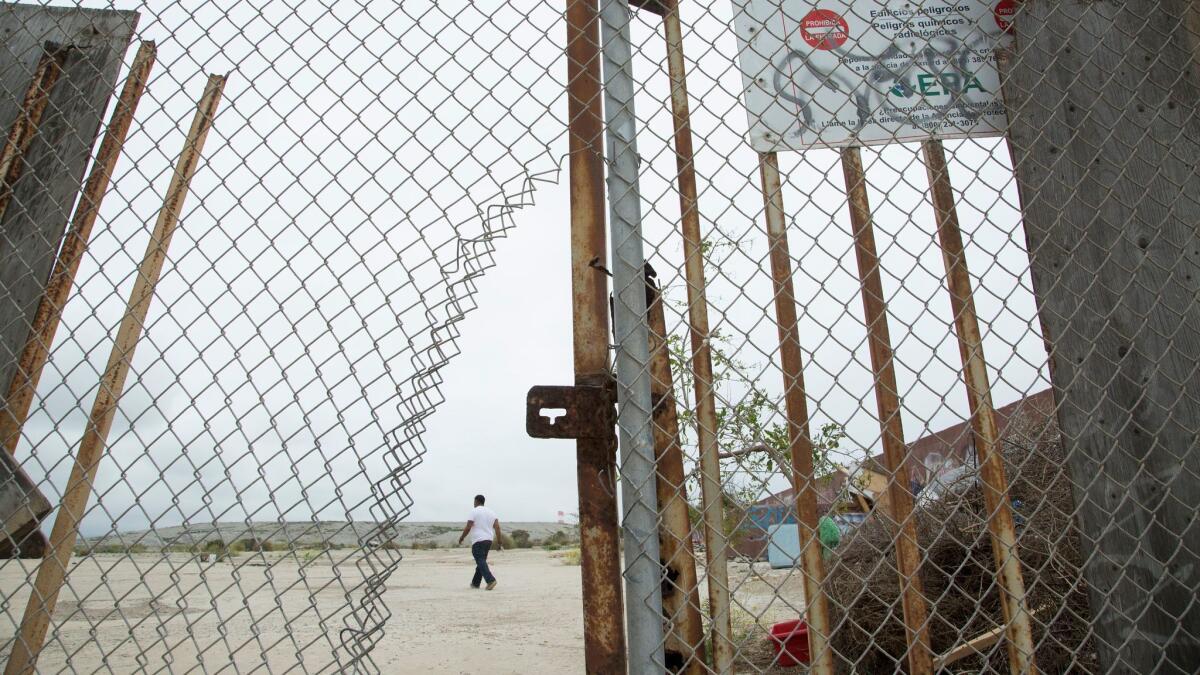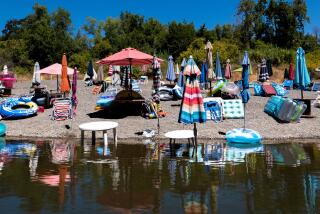Oxnard residents are fighting slag heaps, power plants and oil fields that mar the town’s beaches

- Share via
Reporting from Oxnard — Ventura County’s largest city is a coastal town where miles of power plants, vast tracts of farmland and private oil and gas holdings limit access to the shore.
At Ormond Beach, 750,000 cubic yards of contaminated slag from a former metal recycling plant occupy part of the wetlands. The federal Superfund site stands between the sand and families who live just a few blocks away.
At the north end of the city, McGrath State Beach has been closed to the public since 2014, and an electrical generating station — one of three gas-fired plants on the Oxnard coast — is a towering eyesore and a source of air pollution above the shoreline. A fourth is planned.
Many residents of this predominantly Latino city with a population of 205,000 say they are fed up with the degradation. Their growing dissatisfaction with the condition of large sections of beach has coalesced into an effort to deindustrialize and restore the shoreline of this city that is framed by Ventura and Camarillo and wraps around the town of Port Hueneme.
“We just want to stop the abuse and get our coast back,” said Mayor Pro Tem Carmen Ramirez. “It’s clear who gets stuck with all the dirty stuff. What other city has three power plants and a Superfund site on the beach? The people of Oxnard have paid their dues.”
Since the mid-2000s, activists, community groups and elected officials have defeated an offshore liquefied natural gas facility and successfully pushed the federal government to declare the Ormond Beach mess a Superfund site.
The City Council passed a moratorium to stop new power plant construction on the beach, and municipal officials are revising Oxnard’s key planning documents to eliminate industrial uses on the coast in the future.
More recently, community groups and city leaders have joined with environmentalists and alternative energy advocates, such as hedge-fund billionaire Tom Steyer, to block construction of the Puente Power Project, a new gas-fired electrical generating station at Mandalay Beach.

“A lot of decisions were made many, many years ago, and what was deemed OK then is not OK today,” said Manuel “Manny” Lopez, 90, a retired optometrist and longtime Oxnard councilman turned environmental activist. “We used to think the beach was a good place for industry. But people are more sophisticated now. There is more public support for these places.”
The increasing activism and changing attitudes about the Oxnard coast also reflect a growing movement concerned that low-income, minority communities across the nation often bear a disproportionate amount of harmful pollution from industrial development.
The population of Oxnard is about 75% Latino, 7.5% Asian, 2.4% African American and 1% Pacific Islander. The per capita income is less than $20,000 a year, and nearly half of all adults have less than a high school education.
The city ranks in the top 20% of the most environmentally burdened communities in the state, with some parts ranking within the top 10%, according to the California Environmental Protection Agency.
A lot of decisions were made many, many years ago, and what was deemed OK then is not OK today.
— Manuel “Manny” Lopez, environmental activist.
Statistics from the California Department of Public Health further indicate that Oxnard, which is known for its agricultural production, has more students attending school near the highest levels of toxic pesticide use in the state.
Reclaiming the coast “is an environmental justice issue in terms of exposure to pollutants and getting access to a beautiful natural resource,” said Maricela Morales, executive director of the Central Coast Alliance United for a Sustainable Economy. “People here are exposed to dust and pesticides from farming as well as emissions from power plants and other industrial sources.”
Allegations of unfair treatment of the area’s poor residents and people of color have been raised in the ongoing controversy over whether to build the $250-million Puente Power Project, a replacement for two aging and obsolete generating stations located on 36 acres in the coastal dunes and wetlands of Mandalay Beach.
Southern California Edison owns the site, and Houston-based NRG Energy would build, own and operate the plant, which is unaffected by the city’s moratorium. The old units and stacks would be removed if Puente goes into operation in the next few years.
The natural gas plant is designed to provide extra electricity if needed during peak demand times, such as cold snaps and heat waves.
NRG Energy and its supporters say the new facility would provide a reliable and efficient source of power with lower emissions than the old plants. According to NRG, Puente could start up in 10 minutes compared with as long as 18 hours for the old units.
Nancy Lindholm, president and chief executive of the Oxnard Chamber of Commerce, said the organization supports pristine beaches and renewable energy sources, but there are no practical alternatives yet to the Puente plant.
“In the meantime, we have got to have electricity,” Lindholm said. “Will it be an environmental justice issue if we have no power for an extended period of time?”
The opponents, including community groups, environmental organizations and elected officials, contend there is excess electrical generating capacity in the state today and that alternative energy sources, such as wind and solar power, can be employed instead of Puente.
They point out that the state has set a goal to have renewable energy sources produce half of California’s electricity by 2030.
As the debate unfolded, the California Coastal Commission recommended that NRG Energy consider locations away from the beach and wetlands — on- or off-site. If there are no feasible spots, the planning agency advised NRG to protect the generating station from sea level rise, create ways to access the beach and preserve plant and animal habitat.
In March, the Sierra Club, Communities for a Better Environment and the Central Coast Alliance United for a Sustainable Economy filed an appeal in state court, alleging that the California Public Utilities Commission in its earlier approval of the Puente project did not ensure that Edison complied with state requirements to protect against the disparate treatment of low-income minority neighborhoods that are overburdened with environmental effects.
Will it be an environmental justice issue if we have no power for an extended period?
— Nancy Lindholm, Oxnard Chamber of Commerce
The utilities commission has claimed that Edison’s solicitation and procurement of the Puente power plant met all legal requirements and that consideration of disparate treatment of people in surrounding areas was not required in this situation.
Last month, the California Energy Commission, which is considering the Puente project for approval, ordered a study of alternative energy sources over the objections of NRG Energy. Company officials contend that no additional feasible and cost-effective options have been identified.
Meanwhile, Oxnard city officials, the State Coastal Conservancy and the Nature Conservancy are stepping up plans to restore the Ormond Beach wetlands south of Port Hueneme.
Over many decades, the wetlands have been drained and filled to accommodate a naval air station, farms, marinas, a city dump, a power plant and a metal recycling company that became a federal Superfund site.

During the 1990s, environmental groups started working with city officials, area residents and landowners at Ormond to eliminate lots on the beach and consider how to restore the wetlands.
They completed a feasibility study in 2009, but work proceeded slowly. The first public meeting to discuss ideas and potential plans was held June 20 of this year.
“We are just getting started,” said Christopher Kroll, a Coastal Conservancy official who manages the restoration project. “The feasibility study is now outdated. It does not account for climate change and sea level rise. We need to rethink where we are going.”
Of the wetlands’ original 1,100 acres, about 250 remain, including intact dunes and marshes. They are home to about 200 migratory birds and six endangered and threatened species.
I’ve seen dead chickens dumped at Ormond, trash and tires. It almost makes you feel guilty as a human.
— Elma del Aquila, a recent graduate of Channel Islands High School
The remaining wetlands, however, continue to be degraded by human use, the dumping of refuse, contaminated runoff and abnormally high levels of salinity due to a lack of flushing by the ocean.
“My family never said ‘Let’s go to the wetlands,’” recalled Elma del Aquila, 18, a recent graduate of Channel Islands High School in Oxnard and an opponent of the Puente project. “I’ve seen dead chickens dumped at Ormond, trash and tires. It almost makes you feel guilty as a human being when people do this.”
A major hurdle for the restoration project is the Superfund site. From 1964 to 2004, the now-defunct Halaco Engineering Co. operated a smelting plant on 37 acres to recover valuable metals for recycling.
More than 750,000 cubic yards of slag remain on-site either buried or in giant unlined settling ponds. Some of the waste has contaminated the groundwater and sediment in the Ormond wetland.
U.S. Environmental Protection Agency officials say they are exploring whether the leftover slag can be used and preparing a clean-up plan that is scheduled for public comment in 2018.
Large tracts of agricultural land and another electrical power plant operated by NRG block most public access to Ormond Beach and the wetlands. Only two roads connect inland streets to pathways leading to the beach, and there’s a two-mile gap between them.
But one of them, Perkins Road, may be more of a deterrent to the sand than an attractive portal. As it nears Ormond, there is a municipal sewage treatment plant, a water purification facility, a manufacturer of paper products and finally the abandoned Halaco site, where homeless people have set up encampments and graffiti mars a several hundred yards-long block wall.
“Neighborhoods here are cut off from the coast by industrial properties,” said Lucas Zucker, a spokesman for the Central Coast Alliance. “There are kids who live just a few blocks away and have never been to the beach.”
It’s easier to get to the stretches of Oxnard beach just north of Point Hueneme, on either side of the Channel Islands Harbor. But access gets tricky again above Mandalay State Beach, with only one unmarked route providing a way to reach a long swath of sandy beach and dunes south of the Santa Clara River.

McGrath State Beach, which authorities closed three years ago after the river repeatedly flooded, still allows no public access. The once popular park is one of the best bird-watching areas in California with lush riverbanks and sand dunes along the shore.
Danita Rodriguez, a state park superintendent for the region, said plans to restore and reopen the facility are at a very early stage.
On the municipal level, Oxnard officials are updating the city’s general plan and coastal program — the main planning document to guide future land uses and development along the coast. Local coastal programs are required by the Coastal Act of 1976 and approved by the Coastal Commission.
Carmen Ramirez, the mayor pro tem, said the update will consider zoning changes, locating future industrial uses inland and addressing potential sea level rise. In 2016, amid the Puente controversy, the City Council amended its general plan to prohibit new power plants from being built in environmentally sensitive areas of the coast.
The Coastal Commission provided the city with a $150,000 grant to help pay for the local coastal program work. NRG Energy, however, asked the commission to withdraw the grant, saying Oxnard was misusing the money by proposing changes to its local coastal program that would hamper operations at its Ormond Beach and Mandalay power plants as well as efforts to build the Puente project.
The company called the amendments “a targeted attack on NRG.”
Commission officials responded that the grant was not being misappropriated because the money was allocated to work on methods to deal with sea level rise.
City officials predict that the overall effort to reclaim Oxnard’s industrialized coastline and improve public access will take decades.
When completed, they say, the result will probably be more attractive beaches and more visitors. Property values could increase as well as rents and home prices in the coastal areas. More affluent residents might move in and drive out lower-income residents, many of whom have lived there for generations.
“Once we get it all cleaned up, we will likely have a gentrification fight,” said Morales, director of the Central Coastal Alliance. “That is something we don’t want.”
Follow me on Twitter @LADeadline16
ALSO
Explosion, major fire rocks DWP power station; large swath of Valley without power
Political Road Map: Here’s how aging baby boomers will change the impact of Prop. 13
More to Read
Sign up for Essential California
The most important California stories and recommendations in your inbox every morning.
You may occasionally receive promotional content from the Los Angeles Times.











